QuestionI just adopted a declawed male cat from a shelter, he's nearly 3 years old and was given up with another cat by owners who became allergic. He was in a cage with the other cat who was not declawed but hid beneath a blanket and growled at anyone who tried to touch her. On my way out of the shelter they mentioned that he'd been "off his food" for a few days. (they said he'd been in the shelter 10 days) I didn't worry too much. When they put him in a little caged room with me he squirmed out of my arms, but was very nuzzley and kept turning to get his head and ears scratched and purred. He had a long car ride home and I was able to scratch his ears when he got here and I kept him confined to a small laundry room (haven't done any laundry so as not to scare him) Well he hid behind the washer for 2 days straight. He didn't seem to eat or drink anything and didn't use the litterbox (also no accidents). Whenever I approached him he'd cower and hide. When I did manage to pick him up, it was just like at the shelter, he didn't want to be held, particularly but was very friendly and nuzzly and purring. But the minute that stops he hides and when he sees me again it's like he doesn't know me at all. Runs from me.. same routine as before. So I left him alone, more or less for a couple of days. He's used the litter box a couple of times, I can't detect any eating or drinking really. The last time I had my hands on him he did not seem dehydrated. I picked up his skin and I didn't detect it remaining up at all. When I'm petting him and he's nuzzling he seems healthy, his eyes are bright (freaked out) but bright.. he moves easily his fur is silky and nice. He doesn't mind if I touch his declawed paws (front only) He doesn't bite nor does he seem likely to. He's so friendly and nice in those moments and then when he can casually saunter off, he hides and it's as if he doesn't know me again. He doesn't meow but purrs easily once you have him.
I have since given him full range of my entire (big) house and what I want to know is should I confine him again? I want him to be comfortable so I've put a couple of kitty beds (one covered) in his favorite hiding places. I don't want to try and confine him now if it's just going to confuse him or make it harder for him to integrate into the whole house later.
He's a lovely kitty and shows great potential for being a really nice kitty if he can just relax. And I've read about declawed cats in your other postings and must say it's a terrible thing to do to a cat. What can I do to reassure my fraidy cat? Now that I've let him out of the bag, so to speak.
AnswerAmy,
I would like to thank you for opening up your home and heart to a cat that according to your description sounds as though he's likely got a history of abuse or really bad neglect. It breaks my heart to see cats like this when it's all so preventable and to be honest with some of the things that people justify doing to animals I find myself somewhat ashamed to be human. Rehabilitating this cat is going to be a slow process that will require patience, consistency, commitment and a willingness to allow the cat to come to you. Feeling sorry for this cat or being angry about what he's been through isn't going to help him, it's best to put all of the negative emotions out of your mind when working directly with this cat. This cat's life has probably been a difficult one and it's important to keep things as calm, comfortable and positive as you can for him. It will take time to help this kitty regain his trust in people so it's important to be patient. You want to be the person that creates positive experiences and associations with people and the best way to do that is to forget about the negative aspects of this kitty's past, be totally calm and envision the results that you want for this cat.
Given the fact that this kitty is obviously very fearful I do think that it would be wise to seek the help of a holistic veterinarian, this is simply a vet trained in conventional medicine as well as one or more alternative therapies which can include homeopathy, acupuncture or massage to name a few. A holistic vet will usually take a more natural approach that will help to eliminate this kitty's anxiety rather than using drugs to mask the problem. It's not uncommon for vets who only practice conventional medicine to prescribe anti-anxiety/depressant medications to treat pets with serious anxiety, however these are powerful drugs and their use isn't without risks or side effects, ultimately in my opinion you don't want to go changing a cat's brain chemistry through the use of these medications unless you absolutely have to. I generally suggest that kitty caregivers try to stick with a more natural approach to treating anxiety and other behavioral issues whenever possible. The use of psychotropic drugs does have a place in veterinary medicine, but I prefer to exhaust safer, gentler and more natural options prior to treating cats with mood altering drugs.
You may want to try a homeopathic remedy called Bach's Rescue Remedy which is a blend of flower essences designed to calm and reassure. This remedy is completely safe, you can't overdose on it when used in combination with common sense and I've had some incredible results in situations like this. Rescue Remedy is usually available in health food stores, naturopathic pharmacies, some mainstream pharmacies in the aisle where you would find vitamins and nutritional supplements and I believe that this remedy can also be purchased online. It has been brought to my attention that there is a pet specific version of this remedy, I don't think it really matters which version you use, I use the human version and it works very well for the cats who need some extra help. In this situation I'd recommend that you add 7-9 drops of Rescue Remedy to a fresh bowl of water each morning. You may be surprised at the results, this remedy has worked some miracles in abused/traumatized cats that I've cared for.
One of the key skills when dealing with a fearful cat is to try and make their new world a bit easier for them to cope with. Since you've mentioned the fact that your newly adopted kitty seems extremely fearful and he shuts down completely when he can't hide it's a good idea to start off by reducing the amount of stimulation going into the cat's brain by confining him to a single room with his food, water, litter pan, bed and toys. This approach will allow your cat to feel a bit safer, it takes far less time and energy to become familiar with one room than it does to cope with an entire home. At this stage in the game it's important to understand that although this kitty may have had a very rough start in life he's safe now. It doesn't do the cat any favors if you focus on what may have happened to him at the hands of other human beings in the past. Your kitty is safe, he will be provided for, rehabilitated and hopefully live a long happy life in his new forever home.
You need to be as quiet and calm as possible when performing basic daily care including cleaning the litter pan and providing fresh food and water each day in this kitty's safe room - adding extra stimuli through making noise, speaking, making direct eye contact, etc could potentially create more anxiety for this little guy. A good plan at this stage in kitty's rehabilitation would be to prepare yourself before going into the safe room, visualize the results you'd like to see for this cat's future and don't allow excitement, empathy, sadness or negativity to influence your state of mind. Rehabilitation for this cat may be a fairly long process that will require patience, commitment and consistency, but the bottom line is that it is possible to help this cat to live a happy, healthy, normal life. I would recommend that you avoid touching this cat, giving any eye contact or talking to the cat for the time being, it's extra stimulation that he's just not ready for at this point in time.
At the present time this cat may not have had much in the way of positive experiences when it comes to human beings touching him. This cat has learned through experience that people could hurt or scare him and it will take some time for him to learn new ways of interacting with people. It took some time for the cat to be socialized into his current state in his previous home so it stands to reason that it will take some time to unlearn the fear based behaviors that may have saved his life. The goal of the way that I rehabilitate abused and traumatized cats is to be patient and allow the cat to seek out attention from me on his/her own terms. I realize that taking a passive approach can sometimes take awhile and it can be a bit frustrating so I would encourage you to consider writing a journal describing your kitty's behavior and demeanor each day. Over time you'll be able to look back on the rehabilitation process and it will be easy to see just how far this cat has come.
Speaking to the cat isn't going to be helpful at this stage because it will provide him with another source of unnecessary stimulation when he's already overloaded with his fear. Unfortunately if the cat was physically abused it's quite likely that he was also yelled at. Cats can be quite vocal, but when they are frightened having someone talk to them can actually cause more fear which goes against what you're trying to achieve. Over time this cat will begin to relax and you'll start seeing signs that he's becoming more comfortable with you. As the rehabilitation process moves forward you'll be able to gradually start speaking to the cat in a soft, reassuring voice and work your way up to a normal conversational voice. Once the cat has become comfortable enough with you that he no longer flees, freezes up or hides you can begin working on getting him comfortable with being spoken to.
While eye contact is very important for people in the course of their daily interactions eye contact has a very different meaning in a cat's world - at best eye contact is perceived as incredibly rude, at worst for a kitty with improper socialization or a kitty that has been abused/neglected eye contact can be seen as a direct threat. Cats who are fighting to defend territory start off by staring directly at each other and showing different body postures, if neither cat backs down things escalate to include loud vocalizations, hissing, growling, biting and things ultimately end when one cat finally gives up and leaves the area. Due to the fact that this cat seems to be so traumatized you want to avoid anything that he could view as a potential challenge because a cat that's been abused has the potential to become aggressive if he's challenged or overwhelmed by fear.
Food rewards are a fantastic way of reinforcing behaviors that you want to see from your cat. You should choose foods that are normally considered to be special treats so that your cat understands that he's being rewarded. Choosing a food reward is all about finding out what an individual cat prefers, some cats enjoy commercially made cat treats, most enjoy tuna, salmon or sardines packed in water. Other common favorites include chicken, lamb or beef - you could also give this kitty a tablespoon or so of unsweetened, organic plain yogurt. The majority of cats are lactose intolerant from around 12 weeks of age, however yogurt and cheese contain beneficial bacteria that are normally found within a healthy digestive tract and the lactose in these items doesn't usually cause digestive upsets. If you do plan to give this kitty cheese I'd recommend a serving no larger than a teaspoon because cheese can cause constipation, another tip to consider - most cats really enjoy old cheddar and it contains enzymes that can help to discourage the formation of plaque and tartar on their teeth.
At this stage much of the rehabilitation process is going to be about sitting patiently while waiting for the cat's innate curious nature to resurface. Eventually this cat won't be able to help himself because the way that you've handled him is completely different from how other human beings and he will want to investigate further. It's best not to speak, make eye contact or touch the cat at this point so that you don't spook him and set back his rehabilitation. The cat will show you when he's ready to be handled, many abused, neglected or traumatized cats have actually gone so far as to stick their heads underneath my hand or rub up against me repeatedly. Once this happens you'll want to slowly, gently and calmly return the scratches and pets while keeping sudden movements to a minimum. You will want to pet this cat from below his head rather than above as a way to help build his confidence. When the cat has learned that he can trust you it will be time to allow him limited access to the rest of the house so that he becomes comfortable and begins to trust you regardless of where you are in the house.
Over time it's not a bad idea to have some cat loving friends of different ages, sexes, races and body types come to your home (one at a time at least initially) to help this kitty learn that you aren't the only kind human being in the world. It's certainly important to let you know that there will be times when you see set backs at different stages of the rehabilitation process, when this happens you should go back to a previous step where the cat was comfortable and try the new experiences again in a few days. Once the cat is comfortable with different people, noises and experiences I'd recommend that you start working with this kitty so that he's okay when it's time for him to go to the vet. From the beginning of this cat's rehabilitation it's best if you keep the travel kennel out so that when he must see a vet the kennel isn't unfamiliar or frightening to him. You can make the travel kennel more inviting by leaving the door ajar and covering the carrier with a small blanket or a large towel to create a den-like atmosphere that allows your new kitty to feel hidden from any potential dangers. You can prepare this kitty for a vet exam by doing some gentle basics like looking into his eyes, ears, mouth and running your hands over his body once he trusts you and other people and he's comfortable and confident with being handled.
I would be more than willing to offer help and support with this cat's rehabilitation on this site for as long as you'd like. In the event that the site tells you that you've asked too many follow ups you can just start over again by returning to the expert menu and asking a new question. I wish you luck as you begin the journey to rehabilitate this precious kitty, I think he'll do okay once he settles down somewhat. I'll keep you and him in my thoughts and prayers so that you'll have someone else rooting for you both. If you have any further cat related questions or concerns, please don't hesitate to contact me again, I will do my absolute best to help you out.

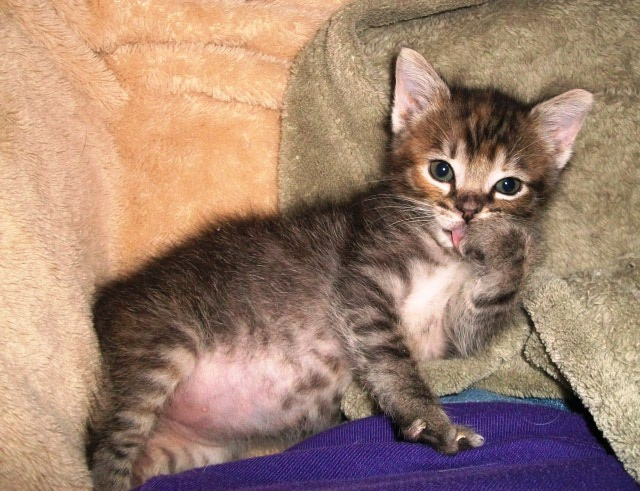 sick kitten
QuestionQUESTION: I have a 1 month old foster kitten th
sick kitten
QuestionQUESTION: I have a 1 month old foster kitten th
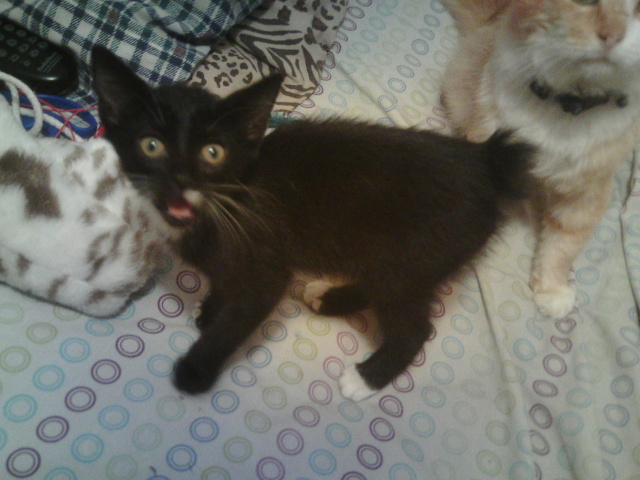 what breed is my bobtail kitten?
Question
Midnight
About a month ago I got a little bobt
what breed is my bobtail kitten?
Question
Midnight
About a month ago I got a little bobt
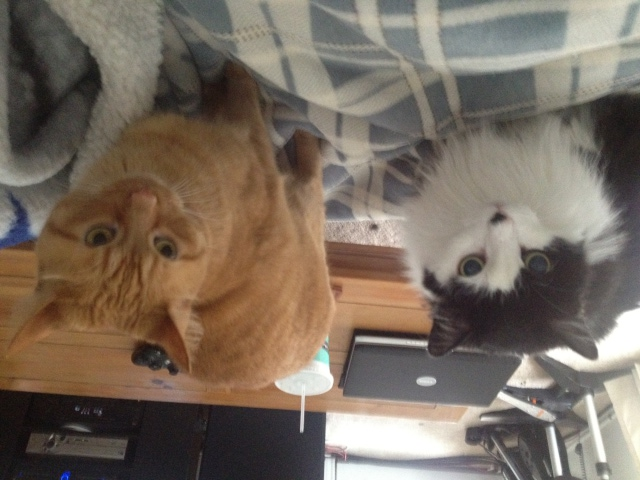 Cat peeing on floor after other cat died
Question
My babies
I have a 6 year old tabby (my
Cat peeing on floor after other cat died
Question
My babies
I have a 6 year old tabby (my
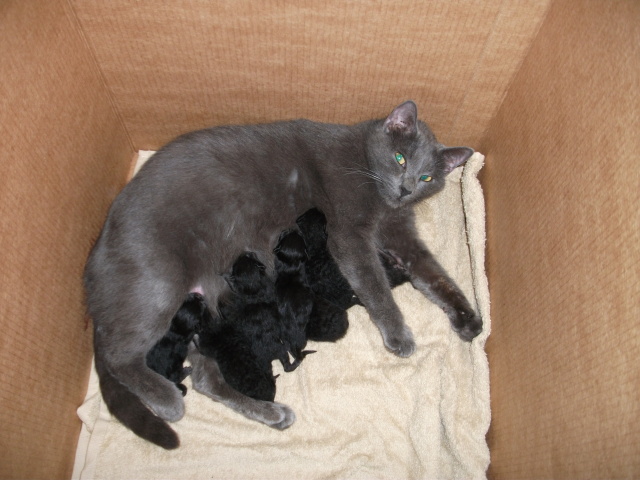 Litter of 9 kittens, born 2/05/10
Question
Smoke and babies
Although we have had 2 adult
Litter of 9 kittens, born 2/05/10
Question
Smoke and babies
Although we have had 2 adult
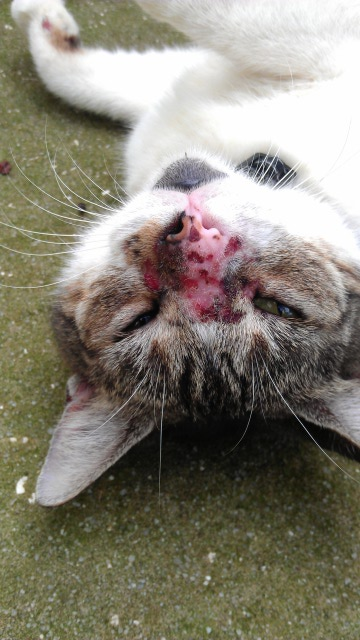 Cat nose
QuestionCat
QUESTION: There is a stray cat in o
Cat nose
QuestionCat
QUESTION: There is a stray cat in o